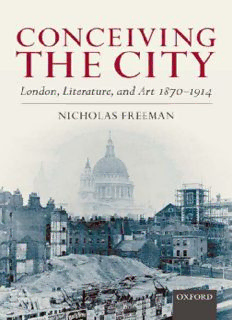
Conceiving the City: London, Literature, and Art 1870-1914 PDF
Preview Conceiving the City: London, Literature, and Art 1870-1914
CONCEIVING THE CITY This page intentionally left blank Conceiving the City: London, Literature, and Art 1870–1914 NICHOLAS FREEMAN 1 1 GreatClarendonStreet,Oxfordox26dp OxfordUniversityPressisadepartmentoftheUniversityofOxford. ItfurtherstheUniversity’sobjectiveofexcellenceinresearch,scholarship, andeducationbypublishingworldwidein Oxford NewYork Auckland CapeTown DaresSalaam HongKong Karachi KualaLumpur Madrid Melbourne MexicoCity Nairobi NewDelhi Shanghai Taipei Toronto Withofficesin Argentina Austria Brazil Chile CzechRepublic France Greece Guatemala Hungary Italy Japan Poland Portugal Singapore SouthKorea Switzerland Thailand Turkey Ukraine Vietnam OxfordisaregisteredtrademarkofOxfordUniversityPress intheUKandincertainothercountries PublishedintheUnitedStates byOxfordUniversityPressInc.,NewYork NicholasFreeman2007 Themoralrightsoftheauthorhavebeenasserted DatabaserightOxfordUniversityPress(maker) Firstpublished2007 Allrightsreserved.Nopartofthispublicationmaybereproduced, storedinaretrievalsystem,ortransmitted,inanyformorbyanymeans, withoutthepriorpermissioninwritingofOxfordUniversityPress, orasexpresslypermittedbylaw,orundertermsagreedwiththeappropriate reprographicsrightsorganization.Enquiriesconcerningreproduction outsidethescopeoftheaboveshouldbesenttotheRightsDepartment, OxfordUniversityPress,attheaddressabove Youmustnotcirculatethisbookinanyotherbindingorcover andyoumustimposethesameconditiononanyacquirer BritishLibraryCataloguinginPublicationData Dataavailable LibraryofCongressCataloginginPublicationData Dataavailable TypesetbyLaserwordsPrivateLimited,Chennai,India PrintedinGreatBritain onacid-freepaperby BiddlesLtd.,King’sLynn,Norfolk ISBN978–0–19–921818–9 1 3 5 7 9 10 8 6 4 2 Preface Thisbookisaninvestigationofthewaysinwhichwritersandartistsapproached therepresentation of London between the death of Charles Dickens in 1870 and the outbreak of the First World War. During these years, London was the most heavily populated city in the world, and one whose physical and psychologicallimitsseemedallbutimpossibletodemarcate.Thefluidnature oftheEnglishcapitalalarmedsomeandexcitedothers,promptinggreatdebate abouthowliteratureandartmightcopewiththeprofoundchallengesofsuch an environment. Much recent scholarship has concentrated on ‘reading’ London,thatistosay,onapplyingcontemporarycriticaltheorytoacanonof literaryworkswhichseemtoforeshadowthemetropolitandevelopmentsand concerns of our own time. The results have been valuable and stimulating, butsuchstudieshaveoftenunderestimatedtheextenttowhichcontemporary theoryisanticipatedbytheinsightsofapreviouscentury. This book attempts to give some sense of the ways in which figures from the worlds of journalism, sociology, literature, and visual art grappled with devising a language of metropolitan representation during the fin de siècle. Theemergenceofthislanguagewasscarcelyacoherentorunifiedproject,for it took many forms and had widely varying degrees of success. Nonetheless, individualswhoostensiblyhavelittleincommonandarenowverydifferently regarded—Monet is a major modern artist, E. V. Lucas is a forgotten hack—madeadeterminedsearchforawayinwhichtheymightcommunicate their sense of a new metropolitan realm. How could any literary or artistic workhopetodojusticetothevastnessofLondon,withitshordesofpeople, itsnoise,itsfogs,itsinsatiableconsumptionofthesurroundingcountryside? AnsweringthisquestiontaxedwritersfromGeorgeGissingtoE.M.Forster, fromHenryJamestoArthurMachen,andartistsfromWilliamPowell Frith toJamesMcNeillWhistler.Itproducedabewilderingselectionofresponses. Attheheartofthesearchforanewlanguagewasthedominantartformof thenineteenthcentury:realism.Ridiculedandmisrepresentedbymodernists, realismwasactuallyasuperblymalleableandadaptablesetofprocedures.Inthe periodunderdiscussion,itabsorbedasemi-scientificmaterialisticnaturalism, mutated into a fragmentary, evanescent impressionism that sought what RobertBrowninghadearliercalled‘theinstantmadeeternity’,andembraced abrooding,mysticallyinformedsymbolismthatdelvedintothedeeperrealities thatlaybeneathoutwardperceptions.Moreimportantly,thesedifferingskeins ofrealistartcontinuedtointertwine,meaningthatawritersuchasFordMadox vi Preface FordcouldmovefromadiscursivesociologicalstylethatdrewuponDickens and Victorian ‘social explorers’ such as Mayhew, to a far more ‘modern’ fragmentarinessinthespaceofafewparagraphs.Artisticallegianceshadyet to calcify into fixed positions, and the results of continued experiment were oftenfascinating,aswellasfar-reaching. ConceivingtheCitybeginsbyalertingthereadertosomeoftheproblemsand challenges posedby London in thelate nineteenth century. It thenproceeds toconsider someoftheforms realism assumed, or someofthemoulds into which it was poured, over an approximately fifty-year period. Rather than focus on individual writers or works, it attempts to read a wide variety of textual and artistic productions alongside one another. It is hoped that this willnotonlyblurtheboundariesofthecanonoflate-Victorianliteratureand artbutwillalsoshowhowoftenideaswhichmightnowberegardedasthoseof FoucaultordeCerteauweredevelopedbywriterswhoarenowrarelyread,let alonestudied. Thestudyisthereforelessacriticismofcontemporarytheory thanatimelyrecognitionofitsorigins. The writing of this book has incurred a great number of intellectual, practical, and social debts. I therefore thank the following institutions and individualsfortheirhelpandencouragement. At the University of the West of England where much of this book was written, I especially thank Dr Alice Entwistle, Dr Kent Fedorowitch, Dr Bill Greenslade,DrBenHighmore,ProfessorRobinJarvis,DrJenniLewis,Profes- sorPeterRawlings,DrGrahamSaunders,andDrVictoriaStewart,allofwhom offered constructive suggestions and advice and answered an unreasonably highnumberoffoolishquestions.ThanksarealsoduetoAmandaSalterand thestaffoftheuniversitylibrary,whosehelpwasalwayspromptandcourteous. IbeganmyexplorationofliteraryLondonwhileapostgraduatestudentat BristolUniversity.HereIwasfortunateenoughtobesupervisedbyProfessor Timothy Webb and Dr Peter McDonald. Only now do I appreciate their struggles in reining in and directing my enthusiasm. Professor Webb in particular did much to clarify my ideas and approach, and I am forever grateful for his insight and hard work, as well as for the scholarly model he offered. I must also thank Dr Michael Bradshaw, Dr Stephen Cheeke, MarjorieDunderdale,JanetGliddon,DrStephenJames,andDrTomMason. My fellow postgraduates Robert Dimbleby, Richard Evans, Dr Ben Hawes, DrBethanJones,andDrAdamRouncewereastutecriticsaswellasconvivial companions:Iamgratefultotheminmanyways. Furtherafield,ProfessorMaxSaundersofKingsCollege,London,DrSara Haslam of the Open University, and Barrie Johnson of the Ford Madox Ford Society kindly shared their knowledge of Ford’s early career. Michael Bott, archivist par excellence at the University of Reading introduced me Preface vii to the Alvin Langdon Coburn photographic collection and other treasures, and could not have been more generous with his time and expertise. The staff of the British Library, the Museum of London, and the University of Birminghamlibrarytrackeddownaplethoraofelusiveworks.Thankstooto JanetWalwynoftheBodleianLibraryforhermuchappreciatedeffortsonmy behalf.ProfessorSimonEliotofLondonUniversityisamineofgoodsenseto whoseencouragementandadviceIamgreatlyindebted.DelegatesatTheCity andtheSublime(UniversityCollegeCork,2000),andthefirstLiteraryLondon conference(Goldsmiths,UniversityofLondon,2002)alsoofferedinteresting suggestions.OthervaluablesupporthascomefromPaulDignum,JonWatson, Lisa Gledhill, Dr Tom Hibbert, and those doughty survivors of the College of Knowledge, Norma, Christopher, Emma and Jessica McCormack, Keith Ripley,andJohnWindsor. Andrew McNeillie and his colleagues at OUP have proved helpful and supportive throughout. Thanks are also due to the anonymous readers who madeanumberofvaluablecriticismsandsuggestions,allofwhichhave,Iam sure,greatlyimprovedthefinalproduct.Ineedhardlyaddthatanyerrorsare myown. Finally,thisbookcouldnothavebeenbegun,letalonecompleted,without thesupportofmyfamily.Mymostprofoundthanksandgratitudearereserved forthem. For permission to quote from the works of Ford Madox Ford, I thank David Higham Associates. Brian Reade granted permission to quote from the writings of Arthur Symons. For permission to quote from the works of ArthurMachen,IthankA.M.HeathandCompany.Forpermissiontoinclude Punch’s ‘The Winter Art Exhibitions’, I thank Punch. The reproduction of Whistler’s Nocturne in Blue and Silver—Cremorne Lights is courtesy of the TateGallery,andAlvinLangdonCoburn’sOntheEmbankmentiscourtesyof the Science and Society Picture Library. The cover picture is courtesy of the GuildhallLibrary,CorporationofLondon. Thematterofcapitalizationistrickythroughout(andalwayshasbeen).TheOxfordManual ofStyledifferentiatesbetween‘Impressionis/m,-t,-tic’whichis‘aspecificartisticmovement orstyleofmusicorwriting’andtheuncapitalized‘generaltendencyorstyle’.However,Ihave seenavarietyofotherusages,andmyscriptchangesthereforeattempttodifferentiatebetween ‘Impressionist’(whichIhaveusedtorefertototheartisticmovementandspecificworksby Monet,Degas,etc.)and‘impressionist’whichhasbeenusedforworkthatislesseasilyidentified assuch.Ihaven’tcapitalizedliteraryimpressionism(orliteraryimpressionists)asIthinkthis givesthemisleadingimplicationthatimpressionistwriterswereacoherentschoolorgrouping. I’vetriedtoapplyasimilardistinctionwhereSymbolismisconcernedinanattempttodif- ferentiatebetweenthosewritersSymonsandothersterm‘Symbolists’(Huysmans,Maeterlinck, etc)andthemorevague‘symbolist’whichI’veusedalotlessprecisely.Ithinkthisisinlinewith wideracademicuseoftheterm,whichseemsremarkablyvagueandcontradictory. This page intentionally left blank Contents ListofIllustrations xi Introduction:TheProblemofLondon 1 AccumulatingImpressions 1 TheCityoftheWorld 4 PassingtheBaton 19 BeingRealistic 26 1. ‘InclusionandConfusion’:EmpiricistLondon 35 FactversusFiction 36 DealingwithDickens(andZola) 43 ‘Arestrictednumberofnaturalfacts’:Londonunderthe Microscope 47 SlummingIt 54 TellingTales 65 ‘Owot’orridlangwidge’:TalkingtotheCockneys 70 TheExactKnowledgeofSherlockHolmes 80 StorieswithoutEnds 86 2. ShadowsandFog:ImpressionistLondon 89 ‘ThealmostawfulclarityofHenryJames’ 89 PaternalPrompting 97 FloatinglikeaButterfly:Whistler 103 ImpressionistCityscapes 112 ImitatingWhistler 118 ImitatingMonet 129 ‘Fleetingandtransitorythings’:SpeedingLondon 134 TowardstheWithin 143 3. ‘Thatuntravell’dworld’:SymbolistLondon 147 DoorsintheWall 147 MysteriesandInitiations 149 FashioningtheSymbol 170 RealistVeils 181
Description: